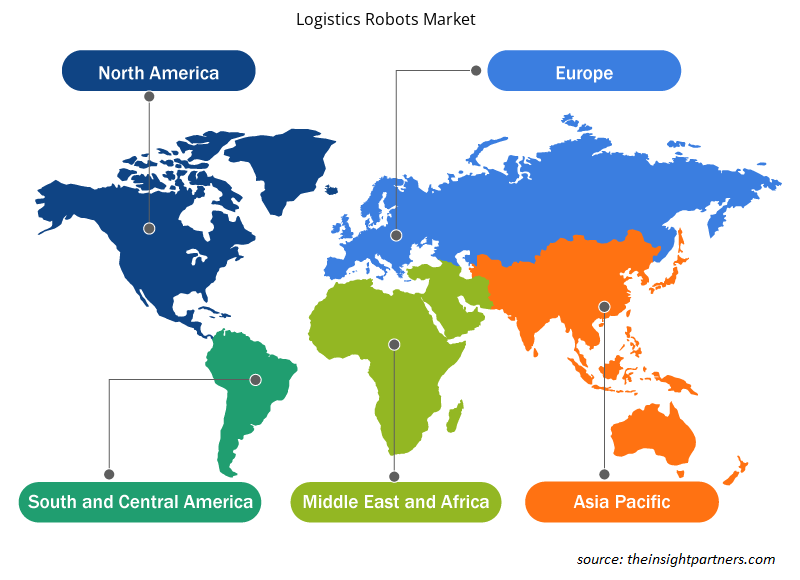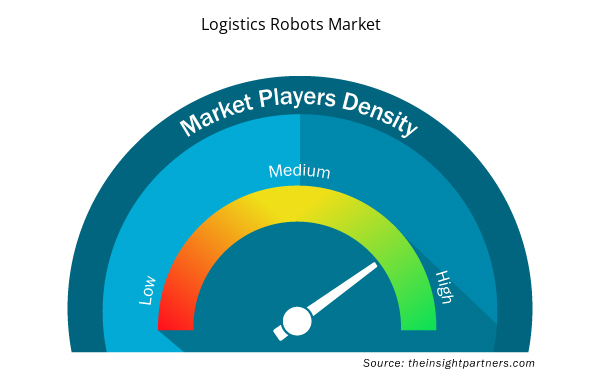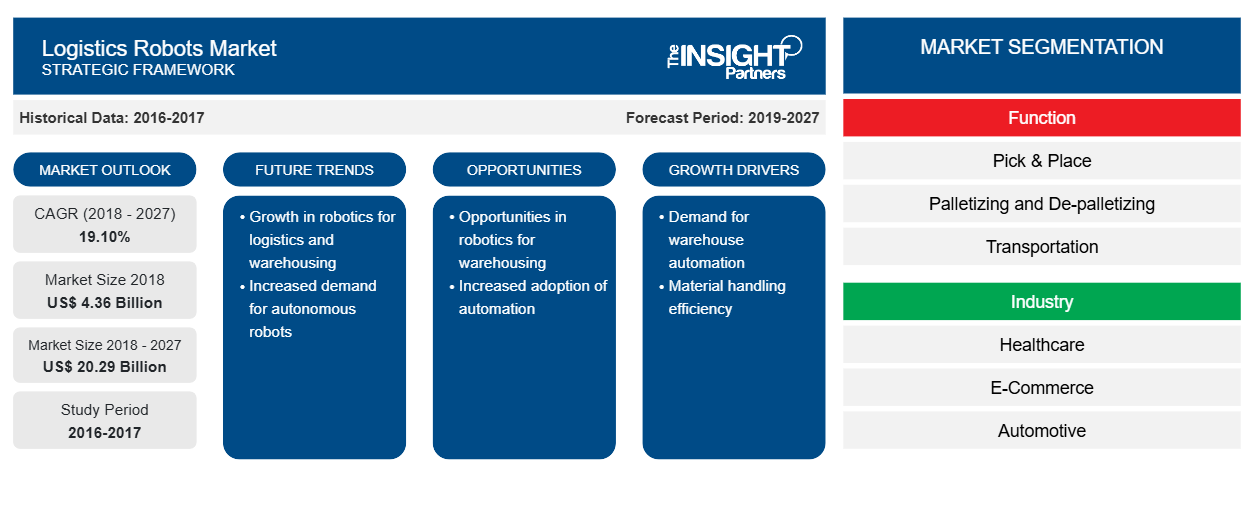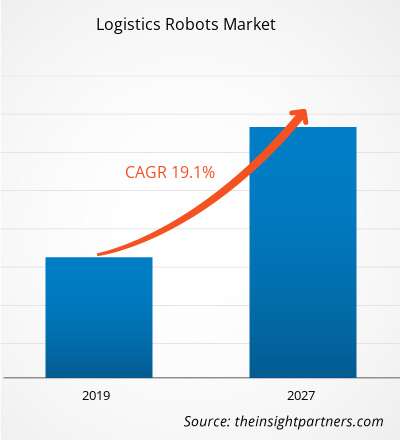Der Markt für Logistikroboter wurde im Jahr 2018 auf 4.356,2 Millionen US-Dollar geschätzt und soll von 2019 bis 2027 mit einer durchschnittlichen jährlichen Wachstumsrate von 19,10 % wachsen und bis 2027 20.293,4 Millionen US-Dollar erreichen.
Die Zahl der Logistik- und Lagerunternehmen, die sich stark auf die Integration von Robotern konzentrieren, um von den Vorteilen einer verbesserten Effizienz, Geschwindigkeit und höheren Gewinnen zu profitieren und auf dem Markt wettbewerbsfähig zu bleiben, nimmt zu. Die Einführung fortschrittlicher Technologien wie robotergestützter Lager- und Logistiktechnologien nimmt zu, um die Betriebseffizienz zu einem erschwinglichen Preis zu verbessern. Der globale Markt für Logistikroboter wird von Faktoren wie einem wachsenden Anteil der alternden Bevölkerung weltweit angetrieben, der zu einem Arbeitskräftemangel führt , und der Erweiterung der Lieferkettennetzwerke weltweit, aber hohe Kapitalinvestitionen für den Einsatz von Logistikrobotern werden das Marktwachstum des Marktes für Logistikroboter im Prognosezeitraum voraussichtlich bremsen. Die zunehmende Lagerautomatisierung und der gut etablierte Markt in den Ländern Asien-Pazifiks und Europas werden jedoch wahrscheinlich erhebliche Wachstumschancen bieten, um den Marktanteil der Branchenakteure in naher Zukunft zu verbessern.
Markteinblicke
Wachsender Anteil der alternden Bevölkerung führt weltweit zu Arbeitskräftemangel
Der weltweit wachsende Anteil der alternden Bevölkerung ist einer der Hauptfaktoren für den Rückgang der Arbeitskräfte in verschiedenen Branchen. In jedem Land der Welt steigt die Zahl älterer Menschen in der Gesellschaft. Die Alterung der Bevölkerung ist zu einem der wesentlichen Faktoren für die sozialen Veränderungen im 21. Jahrhundert in allen Sektoren geworden, sowohl auf dem Arbeitsmarkt als auch auf den Finanzmärkten. Allerdings sind Länder wie Italien, Japan und viele andere die Länder mit dem höchsten Anteil der alternden Bevölkerung, da ein erheblicher Prozentsatz ihrer Bevölkerung über 65 Jahre alt ist. Laut WHO werden bis zum Jahr 2050 voraussichtlich rund 2 Millionen Menschen weltweit über 60 Jahre alt sein, was einer Verdreifachung des Stands von 2000 entspricht. Der Anstieg der Zahl der alternden Bevölkerung ist der Grund für den Arbeitskräftemangel. Der Einsatz von Logistikrobotern in verschiedenen Branchen spielt eine wichtige Rolle, da er die Gesamtkosten des Prozesses senkt, die Produktivität steigert, die Sicherheit verbessert und menschliches Versagen reduziert. Die rasanten technologischen Fortschritte in Lagern weltweit konzentrieren sich auf die Anforderungen im Zusammenhang mit den Schwierigkeiten, mit denen Lieferkettenprozesse konfrontiert sind, und stellen sicher, dass die eingesetzte Technologie mit den Geschäftszielen in Zusammenhang steht. Die Implementierung von Robotern in verschiedenen Einheiten, Funktionen und Phasen des Produktlebenszyklus ist eine der wichtigsten Herausforderungen, denen sich Lager heute auf ihrem Wachstumspfad stellen müssen, was wiederum den Markt für Logistikroboter in naher Zukunft ankurbeln wird.
Passen Sie diesen Bericht Ihren Anforderungen an
Sie erhalten kostenlos individuelle Anpassungen an jedem Bericht, einschließlich Teilen dieses Berichts oder einer Analyse auf Länderebene, eines Excel-Datenpakets sowie tolle Angebote und Rabatte für Start-ups und Universitäten.
- Holen Sie sich die wichtigsten Markttrends aus diesem Bericht.Dieses KOSTENLOSE Beispiel umfasst eine Datenanalyse von Markttrends bis hin zu Schätzungen und Prognosen.
Einblicke in Robotertypen
Das Segment der kollaborativen mobilen Roboter hat den größten Anteil am globalen Markt für Logistikroboter. Sie werden in verschiedenen Branchen für eine Reihe von Aufgaben wie Verpackung, Maschinenbedienung und Materialhandhabung eingesetzt, da diese Cobots leistungsfähig genug sind, um sowohl schwere als auch leichte Aufgaben zu bewältigen. Sie sind hochgenau, flexibel und präzise. Darüber hinaus sind Cobots leicht zu warten und lassen sich leichter neu konfigurieren und programmieren. Diese Roboter können auch sensible Arbeiten erledigen; außerdem passen sie sich selbst an die Inkonsistenzen an, die während der Herstellungsprozesse auftreten. Cobots sind in der Lage, wichtige Kennzahlen für die Bereitstellung von Onboard-Analysen sowie Berichten zu sammeln, um den Entscheidungsprozess zu vereinfachen, der den gesamten Markt für Logistikroboter antreibt.
Funktionseinblicke
Das Transportsegment hat den größten Anteil am globalen Markt für Logistikroboter. Die Waren werden palettiert und es gibt leichte Unterschiede bei verschiedenen Produktformen und -größen, was eine Automatisierung des Be- und Entladens dieser Waren erforderlich macht. Die 3D-Lasersicht ist in die neue Robotersoftware integriert, die den Benutzern hilft, verschiedene Produkte in Containern zu sehen, die ideale Be-/Entladereihenfolge zu bestimmen und den Prozess mit hoher Genauigkeit durchzuführen. Logistikroboter werden zum Bewegen von Zielregalen, Ziehen und Anheben von Körben, Strecken der Gabel auf Regalen und Zurückbringen in die Zielposition eingesetzt und treiben den gesamten Markt für Logistikroboter an.
Brancheneinblicke
Das Segment der ausgelagerten Logistik hat den größten Anteil am globalen Markt für Logistikroboter. Diese Logistikdienstleister bieten verschiedene Dienstleistungen an, darunter Lagerhaltung, Bestandsverwaltung, Transport, Vertrieb, Auftragsabwicklung und Frachtkonsolidierung. Die ständig steigende Nachfrage nach zeitnahem Liefermanagement sowie nach Senkung der Versandkosten, die verstärkte Konzentration auf die Bestandsaufnahme von Material und Kerngeschäft sowie die Reduzierung der Vermögenswerte des Unternehmens werden voraussichtlich den Markt für Logistikroboter im Prognosezeitraum antreiben.
Unternehmen verfolgen häufig verschiedene Strategien für Marktinitiativen, um ihre Präsenz weltweit zu erweitern und der wachsenden Nachfrage gerecht zu werden. Diese Strategie wird vor allem in Europa und im asiatisch-pazifischen Raum verfolgt. Die Akteure auf dem Markt für Logistikroboter verfolgen die Strategie der Expansion und Investition in Forschung und Entwicklung, um ihren Kundenstamm weltweit zu vergrößern, was es den Akteuren auch ermöglicht, ihren Markennamen weltweit aufrechtzuerhalten.
Regionale Einblicke in den Markt für Logistikroboter
Die regionalen Trends und Faktoren, die den Markt für Logistikroboter im Prognosezeitraum beeinflussen, wurden von den Analysten von Insight Partners ausführlich erläutert. In diesem Abschnitt werden auch die Marktsegmente und die Geografie von Logistikrobotern in Nordamerika, Europa, im asiatisch-pazifischen Raum, im Nahen Osten und Afrika sowie in Süd- und Mittelamerika erörtert.

- Erhalten Sie regionale Daten zum Markt für Logistikroboter
Umfang des Marktberichts zu Logistikrobotern
| Berichtsattribut | Details |
|---|---|
| Marktgröße im Jahr 2018 | 4,36 Milliarden US-Dollar |
| Marktgröße bis 2027 | 20,29 Milliarden US-Dollar |
| Globale CAGR (2018 - 2027) | 19,10 % |
| Historische Daten | 2016-2017 |
| Prognosezeitraum | 2019–2027 |
| Abgedeckte Segmente | Nach Funktion
|
| Abgedeckte Regionen und Länder | Nordamerika
|
| Marktführer und wichtige Unternehmensprofile |
|
Marktteilnehmerdichte: Der Einfluss auf die Geschäftsdynamik
Der Markt für Logistikroboter wächst rasant, angetrieben durch die steigende Nachfrage der Endnutzer aufgrund von Faktoren wie sich entwickelnden Verbraucherpräferenzen, technologischen Fortschritten und einem größeren Bewusstsein für die Vorteile des Produkts. Mit steigender Nachfrage erweitern Unternehmen ihr Angebot, entwickeln Innovationen, um die Bedürfnisse der Verbraucher zu erfüllen, und nutzen neue Trends, was das Marktwachstum weiter ankurbelt.
Die Marktteilnehmerdichte bezieht sich auf die Verteilung der Firmen oder Unternehmen, die in einem bestimmten Markt oder einer bestimmten Branche tätig sind. Sie gibt an, wie viele Wettbewerber (Marktteilnehmer) in einem bestimmten Marktraum im Verhältnis zu seiner Größe oder seinem gesamten Marktwert präsent sind.
Die wichtigsten auf dem Markt für Logistikroboter tätigen Unternehmen sind:
- AGV International
- Clearpath Robotik
- Daifuku Co. Ltd.
- Fanuc Corporation
- Fetch Robotics Inc
Haftungsausschluss : Die oben aufgeführten Unternehmen sind nicht in einer bestimmten Reihenfolge aufgeführt.

- Überblick über die wichtigsten Akteure auf dem Markt für Logistikroboter
Markt für Logistikroboter – nach Robotertyp
- Roboterarm
- AGV
- Kollaborative mobile Roboter
- Sonstiges
Markt für Logistikroboter – nach Funktion
- Aufnehmen und Platzieren
- Palettieren und Depalettieren
- Transport
- Verpackung
Markt für Logistikroboter – nach Branchen
- Gesundheitspflege
- E-Einkauf
- Automobilindustrie
- Logistik auslagern
- Einzelhandel
- Konsumgüter
- Essen und Trinken
- Sonstiges
Markt für Logistikroboter – nach Geografie
Nordamerika
- UNS
- Kanada
- Mexiko
Europa
- Frankreich
- Deutschland
- Italien
- Vereinigtes Königreich
- Russland
- Restliches Europa
Asien-Pazifik
- China
- Indien
- Südkorea
- Japan
- Australien
- Restlicher Asien-Pazifik-Raum
Naher Osten und Afrika
- Südafrika
- Saudi-Arabien
- Vereinigte Arabische Emirate
- Restlicher Naher Osten und Afrika
Südamerika
- Brasilien
- Argentinien
- Restliches Südamerika
Firmenprofile
- AGV International
- Clearpath Robotik
- Daifuku Co. Ltd.
- Fanuc Corporation
- Fetch Robotics Inc.
- Kion Group AG
- KNAPP AG
- Kollmorgen
- KUKA AG
- Toshiba Corporation
- Historische Analyse (2 Jahre), Basisjahr, Prognose (7 Jahre) mit CAGR
- PEST- und SWOT-Analyse
- Marktgröße Wert/Volumen – Global, Regional, Land
- Branche und Wettbewerbsumfeld
- Excel-Datensatz



Report Coverage
Revenue forecast, Company Analysis, Industry landscape, Growth factors, and Trends

Segment Covered
This text is related
to segments covered.

Regional Scope
North America, Europe, Asia Pacific, Middle East & Africa, South & Central America

Country Scope
This text is related
to country scope.
Häufig gestellte Fragen
Automated guided vehicles (AGVs) are used for consistent as well as predicted transport of materials. AGVs might be serviced through conveyors, forklift trucks, or manual cart transport systems. The transport of bulk materials using AGVs helps minimize efforts required in repetitive transportation of small chunks of materials, with less human intervention. Apart from distribution and manufacturing, AGVs have also become an integral part of other industries, including retail, military, food & beverages, automotive, and healthcare. The deployment of AGVs benefits businesses by reducing the cost of labor required in manual execution of tasks; enhancing safety, accuracy, and productivity of products; and improving the efficiency of work when integrated with the warehouse management/control systems. Improved work efficiencies further helps streamline other processes, such as materials ordering and inventory management.
With the increasing importance of equipment in logistic markets in APAC, especially China and India, robot manufacturers realize that electronics innovations can complement production innovations in gaining a competitive advantage. Japan is a well-developed economy and is one of the most technologically advanced economies across the world. Also, the region has a few significant manufacturers of robots and factory automation systems such as Fanuc, Mitsubishi Electric, and Omron Corp, among others. The Japanese companies widely use automation solutions to maintain their competitive position in the market.
The continuous growth in consumer expectations is likely to drive continued investment for the adoption of logistics robots for performing operational functions in warehouses. Leveraging the modern supply chain technology as well as the Internet of Things (IoT), the focus on the “smart warehouse†concept is growing, which can serve as a hub to enhance the efficiency and speed of the entire supply chain process. The warehouse automation includes wearable wore by workers to sensors, logistics robots, internet-enabled devices, and smart equipment, which profoundly modify the logistics management. Warehouse management is constantly facing more pressures related to supply chain transformation, commoditization, and rising customer expectations. Therefore, the warehouse automation concept is an effective way to enhance efficiencies, reduce operational costs, and scale operations. The warehouse automation performs various activities such as data collection and inventory control, with million-dollar of investments.
Trends and growth analysis reports related to Electronics and Semiconductor : READ MORE..
The List of Companies - Logistics Robots Market
- AGV International
- Clearpath Robotics
- Daifuku Co. Ltd.
- Fanuc Corporation
- Fetch Robotics Inc
- KION GROUP AG
- KNAPP AG
- Kollmorgen
- Kuka AG
- Toshiba Corporation
The Insight Partners performs research in 4 major stages: Data Collection & Secondary Research, Primary Research, Data Analysis and Data Triangulation & Final Review.
- Data Collection and Secondary Research:
As a market research and consulting firm operating from a decade, we have published and advised several client across the globe. First step for any study will start with an assessment of currently available data and insights from existing reports. Further, historical and current market information is collected from Investor Presentations, Annual Reports, SEC Filings, etc., and other information related to company’s performance and market positioning are gathered from Paid Databases (Factiva, Hoovers, and Reuters) and various other publications available in public domain.
Several associations trade associates, technical forums, institutes, societies and organization are accessed to gain technical as well as market related insights through their publications such as research papers, blogs and press releases related to the studies are referred to get cues about the market. Further, white papers, journals, magazines, and other news articles published in last 3 years are scrutinized and analyzed to understand the current market trends.
- Primary Research:
The primarily interview analysis comprise of data obtained from industry participants interview and answers to survey questions gathered by in-house primary team.
For primary research, interviews are conducted with industry experts/CEOs/Marketing Managers/VPs/Subject Matter Experts from both demand and supply side to get a 360-degree view of the market. The primary team conducts several interviews based on the complexity of the markets to understand the various market trends and dynamics which makes research more credible and precise.
A typical research interview fulfils the following functions:
- Provides first-hand information on the market size, market trends, growth trends, competitive landscape, and outlook
- Validates and strengthens in-house secondary research findings
- Develops the analysis team’s expertise and market understanding
Primary research involves email interactions and telephone interviews for each market, category, segment, and sub-segment across geographies. The participants who typically take part in such a process include, but are not limited to:
- Industry participants: VPs, business development managers, market intelligence managers and national sales managers
- Outside experts: Valuation experts, research analysts and key opinion leaders specializing in the electronics and semiconductor industry.
Below is the breakup of our primary respondents by company, designation, and region:

Once we receive the confirmation from primary research sources or primary respondents, we finalize the base year market estimation and forecast the data as per the macroeconomic and microeconomic factors assessed during data collection.
- Data Analysis:
Once data is validated through both secondary as well as primary respondents, we finalize the market estimations by hypothesis formulation and factor analysis at regional and country level.
- Macro-Economic Factor Analysis:
We analyse macroeconomic indicators such the gross domestic product (GDP), increase in the demand for goods and services across industries, technological advancement, regional economic growth, governmental policies, the influence of COVID-19, PEST analysis, and other aspects. This analysis aids in setting benchmarks for various nations/regions and approximating market splits. Additionally, the general trend of the aforementioned components aid in determining the market's development possibilities.
- Country Level Data:
Various factors that are especially aligned to the country are taken into account to determine the market size for a certain area and country, including the presence of vendors, such as headquarters and offices, the country's GDP, demand patterns, and industry growth. To comprehend the market dynamics for the nation, a number of growth variables, inhibitors, application areas, and current market trends are researched. The aforementioned elements aid in determining the country's overall market's growth potential.
- Company Profile:
The “Table of Contents” is formulated by listing and analyzing more than 25 - 30 companies operating in the market ecosystem across geographies. However, we profile only 10 companies as a standard practice in our syndicate reports. These 10 companies comprise leading, emerging, and regional players. Nonetheless, our analysis is not restricted to the 10 listed companies, we also analyze other companies present in the market to develop a holistic view and understand the prevailing trends. The “Company Profiles” section in the report covers key facts, business description, products & services, financial information, SWOT analysis, and key developments. The financial information presented is extracted from the annual reports and official documents of the publicly listed companies. Upon collecting the information for the sections of respective companies, we verify them via various primary sources and then compile the data in respective company profiles. The company level information helps us in deriving the base number as well as in forecasting the market size.
- Developing Base Number:
Aggregation of sales statistics (2020-2022) and macro-economic factor, and other secondary and primary research insights are utilized to arrive at base number and related market shares for 2022. The data gaps are identified in this step and relevant market data is analyzed, collected from paid primary interviews or databases. On finalizing the base year market size, forecasts are developed on the basis of macro-economic, industry and market growth factors and company level analysis.
- Data Triangulation and Final Review:
The market findings and base year market size calculations are validated from supply as well as demand side. Demand side validations are based on macro-economic factor analysis and benchmarks for respective regions and countries. In case of supply side validations, revenues of major companies are estimated (in case not available) based on industry benchmark, approximate number of employees, product portfolio, and primary interviews revenues are gathered. Further revenue from target product/service segment is assessed to avoid overshooting of market statistics. In case of heavy deviations between supply and demand side values, all thes steps are repeated to achieve synchronization.
We follow an iterative model, wherein we share our research findings with Subject Matter Experts (SME’s) and Key Opinion Leaders (KOLs) until consensus view of the market is not formulated – this model negates any drastic deviation in the opinions of experts. Only validated and universally acceptable research findings are quoted in our reports.
We have important check points that we use to validate our research findings – which we call – data triangulation, where we validate the information, we generate from secondary sources with primary interviews and then we re-validate with our internal data bases and Subject matter experts. This comprehensive model enables us to deliver high quality, reliable data in shortest possible time.


 Holen Sie sich ein kostenloses Muster für diesen Bericht
Holen Sie sich ein kostenloses Muster für diesen Bericht